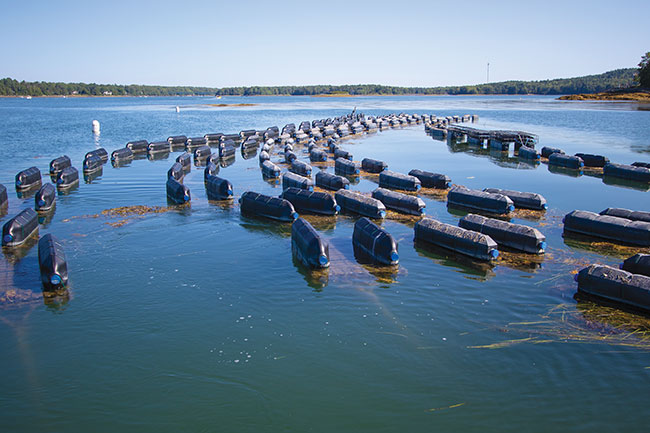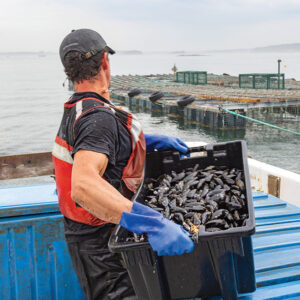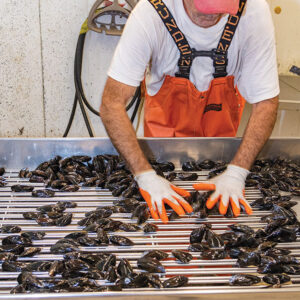
Evolution through education
May 9, 2023
By Timothy Harder
University of New England prepares the next generation of aquaculturists

Aquaculture in the United States has great promise for domestic production of healthy seafood to large, diverse markets but building an industry takes time. The work being done by smaller boutique farmers, as well as some early land-based pioneers shows that domestic production can command a premium in the market to consumers that value a local product. The small handful of net-pen farming operations that still function have ready outlets for their protein as well.
The United States has a robust supply chain for many raw materials, and the ability to source products from all over the world to support this potential growth. It is interconnected by rail and road and can react to many different market forces, as was seen during the recent global challenges. The foundational knowledge among the domestic workforce, however, is something that still needs to be developed. Any aquaculture operation is only as good as the people working on it.
Universities.com lists a total of 26 schools in the U.S. offering aquaculture degree programs. Many of these are smaller schools, in areas already connected with aquaculture on one level or another. Compared to other sectors, this number is dwarfed by the 6,000+ institutions offering degrees in agriculture.
Situated on the coast of Maine at the mouth of the Saco River, the University of New England has been a leader in educating the next generation of aquaculturists for 22 years now. Dr. Jeri Fox is the pioneer of the program since 1998 and has a unique perspective on this field and its evolution over the years.
Dr. Fox has been in aquaculture for over 40 years herself, starting out with a degree in organismal biology from the University of Tennessee. From there, she went on to a graduate program in aquaculture at the University of Houston. She soon connected with Texas A&M doing some shrimp research.
Dr. Fox remembers that in those early days, “It was a very male dominated field when I was starting out. All professors and instructors were men. I was one of only a few women in the field.” The curriculum of the programs early on lacked a certain diversity as well. “The focus was on pond culture, and it was almost entirely freshwater. There was some work being done on mariculture too, but the emphasis was very clearly on the ponds.”
During that time, the aquaculture sector was just getting ready for some explosive growth. Up until 1990, the world produced some 17 million tonnes via aquaculture, but by the end of the decade it would trending up quickly, and already reaching an estimated 41.72 million tonnes (Our World In Data).
“The curriculum today has to cover more diverse processes,” Dr. Fox continues. “Studying pond aquaculture is a good way to cover the basics. Answering questions like ‘What happens in the pond?’, ‘How do you build a pond?’, ‘What is the correct depth of a pond and why?’, are great for developing fundamental understanding, and you can build on these concepts. From there you can talk more about more involved forms of aquaculture such as RAS and hatchery operations.”
Michael Galloway, a graduate of the program at University of New England in 2015, and assistant marine scientist at the school added, “We want the students to know the fundamentals of aquaculture. The biology, the interaction with water and water quality is very important. Even the plumbing concepts and basic equipment is valuable to students starting out in the field.”
Diverse experiences is something that Dr. Jeri Fox brings as a teacher. Along with her time in ponds studying penaeid shrimp she has worked in the Northwest with shellfish and halibut, ornamentals, and even a project in Guam that looked at a more sustainable way to produce a local food fish, without impacting the wild populations.
“The locals were very interested as to why I wanted to collect adult rabbitfish. We were working with them as broodstock in tanks and studying the fatty acid contents of the eggs so that we could improve survivability of the offspring. We were also providing some economic opportunities by teaching the cultivation of ornamentals that can fetch high prices in the market.”
When Dr. Fox arrived at University of New England the classes had been laid out for a course that focused on aquaculture. The entire curriculum still needed to be designed though. During her time there, it has been developed to include work with seaweed, shellfish, and finfish and they have partnered with local businesses for hands-on instruction and field trips.
“We attract students that want to get their hands on things,” said Dr. Fox. “Individuals that want to ‘do something, get wet, get dirty’! Our students may be in the clownfish lab one day, working with live feeds, aquaponics, our RAS System or doing some experiential learning like rebuilding a pump or troubleshooting water quality.”
Interestingly, she has also noticed a shift in the students that reflects a level of consciousness within society. “Early students were interested in aquaculture with a focus on a job and being outside. It has become clear that some of our more recent students engage in aquaculture with a focus that is on more global ideas. Climate change, easing the pressures of overfishing, food insecurity in the world, are all things that aquaculture can positively effect. You can solve a lot of the world’s problems through aquaculture, and that outlook pretty much describes me!”
The Gulf of Maine Research Institute in Portland, Maine has recognized the need for workers in the growing aquaculture sector more locally and is also working with education to address this need. Carissa Maurin is the aquaculture project manager at GMRI, and former student of Dr. Fox’s at UNE. They have started the Workforce Development program that they have helped to stand up at Southern Maine Community College.
“This is not a college degree and is done with the goal to give people the skills for a job so that the state of Maine can begin to develop a pipeline of employees within the industry. College may not be for everyone, but we recognize the need of giving people some basic skills and opportunities through paid internships.” said Dr. Fox.
The program has an agreement with the USDA for six apprentices to work with local farmers in the state on a paid internship. During that time, the students get 144 hours of instruction at Southern Maine Community College. This includes a ‘Boot Camp’ to help students understand the different career paths, and the basics that are needed on a farm such as nautical skills and chart reading, boat engine maintenance, food safety and biosecurity. During the internship, students take part in a monthly speaker series from within the industry intended to give them a broad idea of the people and roles within aquaculture.
GMRI and SMCC worked with the Maine Aquaculture Association to help develop the curriculum, as well as fielding input from industry experts, and even feedback from the RAS-Network. At the end of their time of two weeks, the college style course requires students to present on their experiences, and take part in learning about more growing techniques, proper record keeping and some disease management. They are also working to develop a badging system that would give students college credits. Washington Community in eastern Maine is also beginning to partner with Cooke Aquaculture and Kingfish Maine on similar programs.
Carissa shared some of her observations about year one of this work. “In the application process, we saw a lot of people ‘transitioning in life’ – People who had worked professionally or already graduated that were looking to try something new, work with their hands and help the environment. We were surprised at the turnout for the program. Even though it was the first year and we had only six spots, we got almost 30 applicants and a number of other people that wanted to know; ‘How can I get into the industry?’ and ‘Can I just take the Boot Camp class?’.”
The interest in aquaculture in Maine is a good sign, and Carissa said that, “There were opportunities to connect people with job boards and creating connections between with industry. This is the most rewarding part of the job, and I can’t wait to see what year 2 of the program brings!”
The education opportunities at the University of New England and Southern Maine Community College are two examples of how to prepare the next generation of aquaculturists. Demand is rapidly rising in some sectors here in the region, such as shellfish and macroalgae farming, and there is a clear horizon for commercial finfish farming once larger projects become reality. Dr. Fox and Michael Galloway at UNE along with Carissa and the SMCC staff and GMRI are helping to prepare the next generation of workers for these positions.







